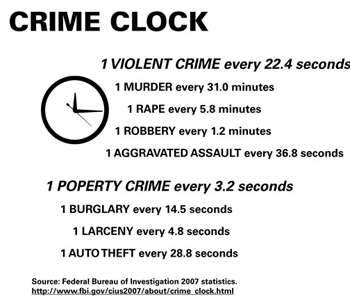Module 1: Program Overview
Crime in America
The Need for Volunteer Victim Service
 Why do citizens like you need to get involved with crime prevention and serving crime victims? Because crime touches us all.
Why do citizens like you need to get involved with crime prevention and serving crime victims? Because crime touches us all.
One out of every seven Americans is the victim of violent or property crime according to the International Association of Chiefs of Police, and as many as 31 million U.S. citizens are victims of violent or property crime every year.
Worse still, the great majority of crime goes unreported. That means that untold victims of crimes associated with drug abuse, alcoholism, domestic violence, child abuse, and abuse of older people and persons with disabilities never get help.
The Criminal Justice Process
Fighting crime in the United States requires an army of justice system employees. In 2003, nearly 2.4 million federal, state, and local workers were employed with law enforcement agencies, prosecutors' offices, the courts, and corrections, at an annual cost of $638 to every man, woman, and child living in America. 1
To crime victims, the process can sometimes seem bewildering. Good Samaritans often find that a crucial component of their service is to educate the crime victim about how the system works, especially if the volunteer is accompanying the victim to court or helping with paperwork such as filling out crime victim compensation forms.
To see how a typical criminal case is prosecuted, view the chart. (Note: Each state's process may vary.)
Crime Victimization
In 2007, U.S. residents age 12 or older experienced approximately 23 million crimes, according to findings from the National Crime Victimization Survey.2
- 76% (17.5 million) were property crimes
- 23% (5.2 million) were crimes of violence
- 1% (194,100) were personal thefts
The Bureau of Justice Statistics estimates that in 2003, about 16.7 million households included at least one member who suffered a violent or property victimization. About 3.5 million households suffered a violent victimization.
Although the Federal Bureau of Investigation reports that the overall crime rate has been going down nationwide, for many communities crime rates are still increasing.
Regardless of a community's crime rate, each victim experiences the aftereffects of crime in an intensely personal way, often suffering—
- Physically
- Victims who are older or have disabilities are especially vulnerable to long-term or permanent injury from broken bones or falls.
- Financially
- People with low or fixed incomes may not be able to afford food or medicine or be able to pay for utilities or rent if a check is stolen or a purse snatched.
- Psychologically
- Crime is very traumatic for victims and can lead to depression, chronic feelings of helplessness, and abuse of alcohol or other drugs.
1. Bureau of Justice Statistics Web site, Justice Expenditures and Employment in the United States, 2003: https://www.bjs.gov/index.cfm?ty=pbdetail&iid=1017.
2. National Crime Victimization Survey, Bureau of Justice Statistics, 2007. https://www.bjs.gov/index.cfm?ty=dcdetail&iid=245




